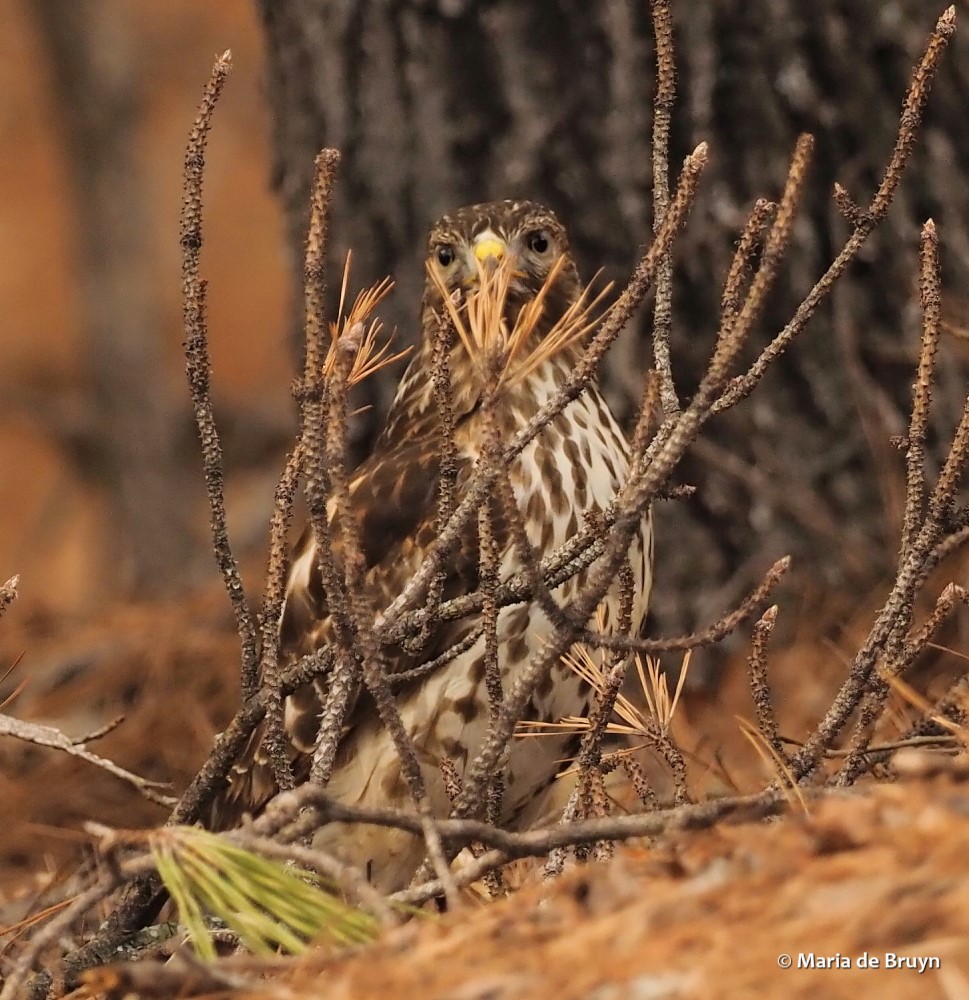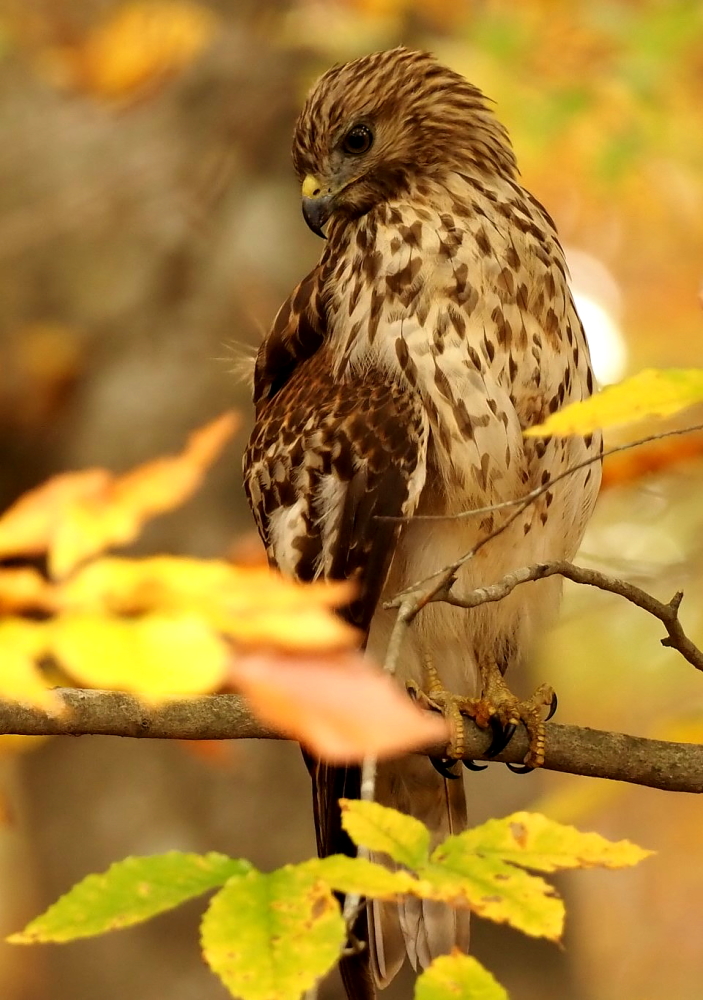
After focusing mostly on the genus accipiter hawks in my last blog (especially the Cooper’s), I’d like to share a few more photos of buteo hawks that are common where I live. Taken over the past 4 years or so, the photos will vary and show them in various seasons.
The buteos are larger birds than the accipiters and somehow seem a bit more relaxed to me than the feisty accipiters.

The red-tailed hawks (Buteo jamaicensis, above) are beauties as adults with dark red tail feathers. I tend to see them most often when I am away from home, visiting fields and natural areas. Frequently, I spot them when they are hunting. Their diets are rich and varied since they see almost any small animal as a potential meal. That includes rodents, rabbits, reptiles, fish, amphibians, invertebrates and other birds.

Those dietary choices mean that I regularly see them being chased by other birds, especially in the spring when the other birds want to protect their nestlings from the predatory beaks of the red-tails. Crows especially can get very raucous and angry when red-tailed hawks are near their nests.


The red-tailed hawk below was being chased away as s/he flew away with a squirrel.

There are 14 recognized sub-species of red-tailed hawks, which vary in color and range. In the area where I live, we have many Eastern red-tailed hawks, but last year I spotted another type flying over farmland. I asked experts from a raptor identification group for some assistance in describing it.

One expert remarked: “This is a juvenile by the monochromatic brown tones, spotted bellyband and lack of dark terminal band on the wings….As a juvenile there is more overlap in phenotype than in adults, and often we cannot identify them to subspecies level.” She went on: “…this bird could be either a slightly heavier marked Eastern (borealis) or a Northern (abieticola). To me it is not heavily enough marked to be a slam dunk abieticola and I would probably not assign a subspecies to it.”

I asked if that meant that a Northern red-tailed hawk could be found in North Carolina and not just the Eastern sub-species, so I could start watching for those distinctions. She responded: “only in winter and probably not overly often that far south, but certainly worth keeping a look out for them.” I haven’t seen this hawk again to my knowledge.

One of my favorite portrait photos (below) is of a red-tailed hawk. Taken in 2015, the bird flew across a field to perch in a tree right next to the path on which I and four other people were walking. S/he had seen a hispid cotton rat crawl into the vegetation underneath the tree. My birding companions walked on but I stayed and after 20 minutes or so, the hawk suddenly dropped down and snagged the rat, which must have had a terrifying wait at the end of its life. The hawk was very handsome though.

While the red-tailed hawks are impressive, I have a softer spot for the red-shouldered hawks (Buteo lineatus). Somehow they look less fierce and a bit sweeter to me.
I see them carrying out all kinds of behaviors. Sometimes, they are just flying overhead, showing off their red shoulders as they travel aloft.

They often perch high in trees to survey their territory.





Tree tops often serve as a place to cuddle up when it is cold.


They seem to enjoy preening when high up on snags at all times of year.



A snag can be a place to call out to mates.

And a level branch is a good place to mate.

Sitting very still, they scan the ground to spot prey, which they often capture by dropping straight down to kill it in a fast strike. Their diet is varied, including many types of rodents and mammals such as squirrels, mice, chipmunks, voles. They also attack birds up to the size of jays, grouse or pheasants.

When I’ve seen them snag prey, it has usually been smaller prey such as frogs, lizards, snakes and other reptiles and amphibians. A pair of red-shouldered hawks living at an urban park in a nearby city must really enjoy the crayfish that are abundant in the wetlands.

These hawks will perch on many handy lookout posts when surveying the ground for prey. This one sat on a feeder at the local public library, suddenly flew a short way to drop down into the leaves and brush under nearby trees and seemed to be wrestling with a rodent of some kind. S/he left without the prey, however.



In my yard, a resident red-shouldered hawk not only sits on branches but occasionally on a nest box, to the dismay of nearby songbirds. One ate all the large green frogs in my pond.

At a small public park in a neighboring town, I watched a red-shouldered scan the field below intently for quite some time. The raptor then surprised me by dropping swiftly down, snagging something small and flying up to another tree to eat.

It wasn’t until I enlarged the photos I took that I saw the bird had gotten a large worm. (When I posted the photo on facebook, a witty commentator remarked that he was collecting bait to go fishing!)


Occasionally, they may be injured. This young hawk was perched in an out-of-the-way spot in a park and when I posted these photos, a commentator remarked that the bird looked injured with a wing out of place. She suggested I contact a rehabilitator but the bird eventually flew away seeming to be ok.


While I know these raptors can be just as fierce as the other hawks, I do tend to think of the red-shouldered hawks as having sweet faces. Having watched them tend to their young, I know they can be very devoted parents and I always enjoy seeing them!

Final note: “I love me some hawks” is not a title I would have chosen some years ago, but I liked it for this blog as it indicates —to me —enjoyment of something. I decided to look up where the phrase came from and ended up with several explanations: 1) an ungrammatical expression that might be associated with African American vernacular or with the rural areas of the southern US states; 2) an annoying phrase usually used by the middle-class; 3) a slang way of saying ‘I really love’; 4) a novel grammatical structure indicating “I always like” something. Kinda like the middle voice in ancient Greek. Well….at least I learned something new today. 😊

Next blog – no birds but interesting creatures nonetheless!

Gorgeous photos!! I really like how you capture the hawks in flight. And I agree that the red shouldereds have gentler expressions than other hawks – they seem more serene in the world as they perch and gaze about. And isn’t there an expression in a song that goes, “I cried me a river over you”? Colloquial English does have a middle voice!
LikeLiked by 1 person
Thanks for your observations, Lucretia! I was a bit surprised by the judgmental remarks about the phrase “I love me some”; the writers must be real sticklers for grammar or a bit snobbish. Something the birds don’t need to worry about when they vocalize! 🙂
LikeLike